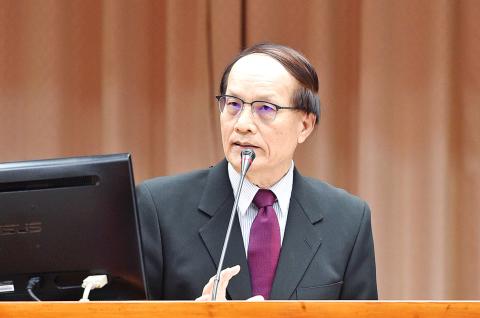The National Palace Museum in Taipei is planning to close for renovations for three years beginning at the end of 2020, Chinese Nationalist Party (KMT) Legislator Ko Chih-en (柯志恩) said yesterday.
Museum Director Chen Chi-nan (陳其南) delivered a report to the Education and Culture Committee at the Legislative Yuan in Taipei and Ko said that documents given to her during a question-and-answer session by museum staff showed that the museum’s library would close on July 1 following an exhibition featuring works by artist Chang Dai-chien (張大千).
The museum’s main building is expected to close at the end of 2020 and be cleared out starting in 2021, with renovation work to take place in 2022 and 2023, she said.

Photo: George Tsorng, Taipei Times
The museum, which houses a wide collection and attracts nearly 5 million visitors each year — the majority of them foreign tourists — has not closed since it was founded, she said.
Ko expressed concern over whether the museum had measures in place for a closure of such magnitude.
The New National Palace Museum Plan documents that the Taipei branch would undergo renovation and expansion work, Chen said, adding, however, that the document did not outline the schedule, as it was not ready when the document was written.
Almost all of the museum’s buildings are to be renovated, he said.
He said museum staff have experience hosting exhibitions and operating amid construction and the consensus was that they would not repeat that experience.
Asked by Ko to clarify whether artifacts at the Taipei branch would be moved to the National Palace Museum Southern Branch in Taibao City (太保), Chiayi County, during the three-year closure, Chen said the museum considers both branches to be part of the museum, so regardless of the duration of renovations — be it three years or five — it would not be a closure, but rather a change of venues.
The museum hopes to attract more foreign visitors to the southern branch, Chen said, adding that while three-quarters of visitors to the Taipei museum are foreigners, the southern branch struggles in this regard.
Separately yesterday, Chiayi County Commissioner Helen Chang (張花冠) said she proposed years ago that the museum’s items be exhibited at the southern branch.
The Chiayi City Government welcomes this move, she said, adding that it would bring more tourists to Chiayi and spur national development.
However, Democratic Progressive Party Taipei mayoral candidate Pasuya Yao (姚文智) yesterday echoed concerns that renovation work at the Taipei branch would affect tourism in the capital.
Yao said the Chiang Kai-shek Memorial Hall should be converted into the museum’s second venue in Taipei.
Then it could be used to exhibit the museum’s most popular artifacts, he said.
Additional reporting by Chou Yan-yu

A magnitude 7.0 earthquake struck off Yilan at 11:05pm yesterday, the Central Weather Administration (CWA) said. The epicenter was located at sea, about 32.3km east of Yilan County Hall, at a depth of 72.8km, CWA data showed There were no immediate reports of damage. The intensity of the quake, which gauges the actual effect of a seismic event, measured 4 in Yilan County area on Taiwan’s seven-tier intensity scale, the data showed. It measured 4 in other parts of eastern, northern and central Taiwan as well as Tainan, and 3 in Kaohsiung and Pingtung County, and 2 in Lienchiang and Penghu counties and 1

FOREIGN INTERFERENCE: Beijing would likely intensify public opinion warfare in next year’s local elections to prevent Lai from getting re-elected, the ‘Yomiuri Shimbun’ said Internal documents from a Chinese artificial intelligence (AI) company indicated that China has been using the technology to intervene in foreign elections, including propaganda targeting Taiwan’s local elections next year and presidential elections in 2028, a Japanese newspaper reported yesterday. The Institute of National Security of Vanderbilt University obtained nearly 400 pages of documents from GoLaxy, a company with ties to the Chinese government, and found evidence that it had apparently deployed sophisticated, AI-driven propaganda campaigns in Hong Kong and Taiwan to shape public opinion, the Yomiuri Shimbun reported. GoLaxy provides insights, situation analysis and public opinion-shaping technology by conducting network surveillance

‘POLITICAL GAME’: DPP lawmakers said the motion would not meet the legislative threshold needed, and accused the KMT and the TPP of trivializing the Constitution The Legislative Yuan yesterday approved a motion to initiate impeachment proceedings against President William Lai (賴清德), saying he had undermined Taiwan’s constitutional order and democracy. The motion was approved 61-50 by lawmakers from the main opposition Chinese Nationalist Party (KMT) and the smaller Taiwan People’s Party (TPP), who together hold a legislative majority. Under the motion, a roll call vote for impeachment would be held on May 19 next year, after various hearings are held and Lai is given the chance to defend himself. The move came after Lai on Monday last week did not promulgate an amendment passed by the legislature that

AFTERMATH: The Taipei City Government said it received 39 minor incident reports including gas leaks, water leaks and outages, and a damaged traffic signal A magnitude 7.0 earthquake struck off Taiwan’s northeastern coast late on Saturday, producing only two major aftershocks as of yesterday noon, the Central Weather Administration (CWA) said. The limited aftershocks contrast with last year’s major earthquake in Hualien County, as Saturday’s earthquake occurred at a greater depth in a subduction zone. Saturday’s earthquake struck at 11:05pm, with its hypocenter about 32.3km east of Yilan County Hall, at a depth of 72.8km. Shaking was felt in 17 administrative regions north of Tainan and in eastern Taiwan, reaching intensity level 4 on Taiwan’s seven-tier seismic scale, the CWA said. In Hualien, the